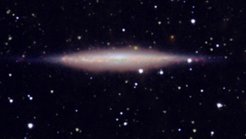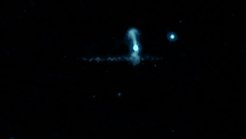Two Galaxies for the Price of One
Surprising Image Reveals New Tool to Study Magnetic Fields of Galaxies

The edge-on spiral galaxy UGC 10288 (horizontal) appeared to be a single object in previous radio telescope observations. However, new, detailed radio data (cyan in this image) from the NRAO's VLA reveals that the large perpendicular (vertical) extension really is a distant background galaxy with radio jets. The foreground image of UGC 10288 includes data from optical, infrared and radio telescopes. While radio data are blue, infrared observations from NASA's Spitzer Space Telescope and Wide-field Infrared Survey Explorer (WISE) are yellow and orange, respectively. Optical data from the Sloan Digital Sky Survey are purplish blue and show starlight; and optical data from the Kitt Peak National Observatory are rose and show heated gas.
As part of a study of 35 galaxies, the astronomers observed one called UGC 10288, a spiral galaxy more than 100 million light-years distant that appears edge-on as seen from Earth. Their multiple VLA observations in 2011 and 2012 produced the best radio-telescope images of that galaxy ever made. The detailed images surprisingly revealed a more-distant galaxy, with strong radio emission, almost directly behind UGC 10288. In previous images, the two galaxies had been blended together. It is probably the first detection of an alignment of a foreground galaxy with such a strongly- emitting background galaxy with extended jets. The background galaxy is much further away, in a distance of nearly 7 billion light-years from Earth.
"This changed the picture, quite literally," says Judith Irwin, of Queen's University in Ontario, Canada. "It changed our understanding of the characteristics of UGC 10288, but also gave us an unexpected new tool for learning more about that galaxy."
The first insight gleaned from the improved images was that UGC 10288 is not forming stars as rapidly as the astronomers first thought. This is because much of the radio emission in the previous, blended images came from the background galaxy.
The new images also showed that the gas in the galaxy's "outskirts," high above its spiral disk does not form a smooth halo-like envelope as result of an extremely low star formation rate.
The background galaxy, and the fact that it is aligned with its radio jets perpendicular to UGC 10288's disk, provides a valuable means of studying the nearer galaxy. "We can use the radio waves from the background galaxy, coming through the nearer one, as a way to measure the properties of the nearer galaxy," says Jayanne English, of the University of Manitoba.
“The use of the more distant galaxy as a background candle has given us the opportunity of magnetic-field measurements in different areas of UGC 10288,” explains Marita Krause from the Max-Planck-Institut für Radioastronomie in Bonn, Germany. “Since the background galaxy is vertically orientated, we can study the magnetic field of the foreground galaxy from the disk up to regions high above.”
The researchers could measure the magnetic field via the effect of Faraday rotation which rotates the polarization plane of the radio emission of the background galaxy within the foreground galaxy.
"Ironically, the radio brightness of UGC 10288 alone is too weak to be included in the original sample, had it not been boosted by the unresolved background galaxy in earlier images," concludes Rainer Beck, also from Max-Planck-Institut für Radioastronomie. “We would have missed an excellent opportunity for magnetic field studies via extended background sources.”


Marita Krause and Rainer Beck, both from Max-Planck-Institut für Radioastronomie (MPIfR), Bonn, Germany, worked with an international team of astronomers from North America, Europe, and India who are part of the Continuum Halos in Nearby Galaxies - an EVLA Survey (CHANG-ES) consortium, led by Judith Irwin. The scientists report their findings in the December issue of the Astronomical Journal.
The National Radio Astronomy Observatory (NRAO) is a facility of the National Science Foundation, operated under cooperative agreement by Associated Universities, Inc.


